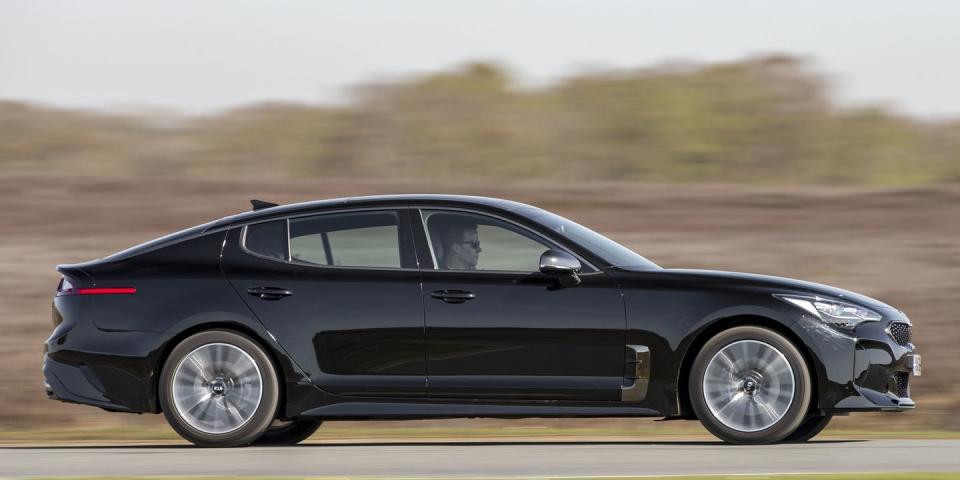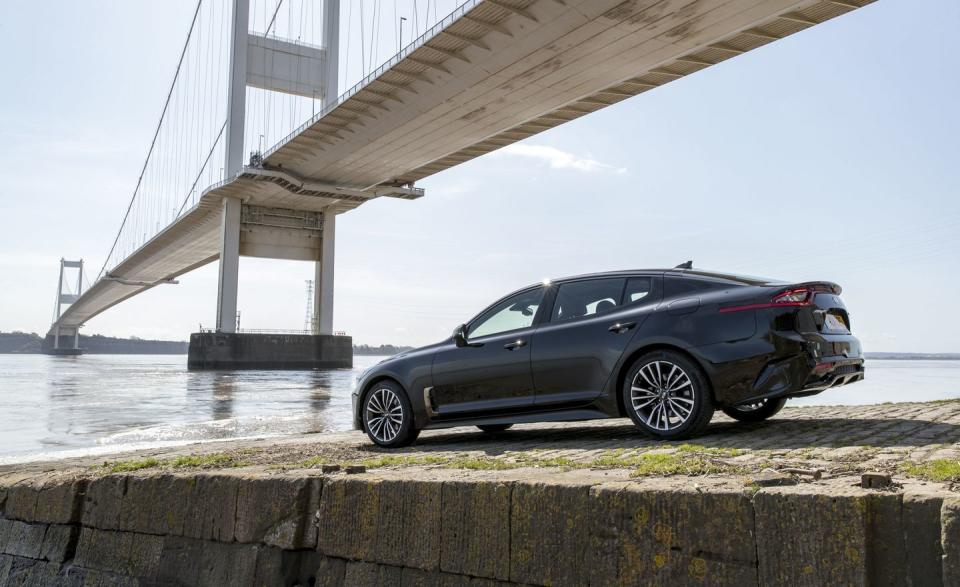A Diesel Engine Transforms the Kia Stinger—for the Worse

There are many diesels that we should regret the capricious powers of market forces denying us. The Kia Stinger CRDi is not one of these. While the rest of the Stinger remains a stylish and compelling proposition, the compression-ignition variant-available exclusively in Europe-lacks much of the dynamic sparkle that makes its gasoline-powered siblings such characterful companions.
The third model in the Stinger family has been designed to satisfy European demand for diesel-powered premium models, with diesels in most Continental markets accounting for about half of all sales. But it feels like a marketing-led solution to a problem rather than a compelling car in its own right. Put simply, the Stinger's stylish hatchback bodywork and fine driving manner deserve better than this old-fashioned engine.
Not So Fresh
Without the budget to develop an all-new four-cylinder diesel for the Stinger, Kia has given the Stinger the same 2.2-liter turbo-diesel inline-four that powers Euro versions of the Kia Sorento and the Hyundai Santa Fe, an engine that dates back a decade. Although its power and torque numbers are respectable-with 197 horsepower and 325 lb-ft, it has slightly more oomph than the BMW 420d Gran Coupe-this engine disappoints on both refinement and efficiency.
Even around-town speeds bring a thrumming soundtrack and a noticeable amount of vibration through the pedals and occasionally through the steering wheel. There's plenty of low-down torque, and the standard eight-speed automatic gearbox-the same one fitted to gasoline-powered Stingers-shifts with its customary deftness, keeping the engine in its broad midrange where it's happiest. But requests for harder acceleration are accompanied by uncouth noises from ahead of the firewall. In terms of finesse, it feels at least a generation behind its more polished European rivals.
The Stinger's accelerator pedal has both a long travel and a heavy weighting that acts to discourage exploring its farthest reaches, but when prodded hard, the CRDi does deliver respectable thrust. Kia claims a 7.3-second zero-to-60-mph time-again, just fractionally better than what BMW claims for the 420d Gran Coupe. Left in drive, the autobox shifts some way short of the 4500-rpm redline; peak power comes at 3800 rpm, and the gearbox shifts quickly enough that there is little point going further. Manual gear selection is possible using steering-wheel-mounted paddles, but the transmission has a bad habit of reverting to drive after only a brief period with no driver input; there's no way to keep it in full manual mode.
Familiar Chassis
The rest of the Stinger CRDi driving experience is similar to that delivered by the four-cylinder gasoline version. Chassis settings are firm but well damped, and although it lacks the adaptive dampers of pricier Stingers, the diesel has a long-legged gait that coped well with the low-quality British asphalt that made up much of our drive route. The steering doesn't have the sharp initial response that German manufacturers usually include in their pursuit of sportiness, and the slower on-center rack actually allows more feedback to reach fingers, although it does make the Stinger feel more reluctant to attack tighter turns.
There are different dynamic modes, but the various settings have limited effect. The punchier Sport setting masks the steering's communication under an unnecessary extra dose of weight and brings an obviously artificial synthesized engine note into the cabin. There's even a Sport+ mode beyond that, which seems entirely redundant in a car so intent on making unhurried progress.
Doesn't Add Up
For European buyers, the diesel Stinger's biggest problem is its mediocre fuel economy, and-of more import-the related CO2 emissions numbers, which determine tax rates in many European countries. On the notoriously optimistic European combined driving cycle, it scores the equivalent of 41 mpg. That's substantially worse than the 48 mpg of that pesky BMW 420d Gran Coupe, not to mention the 57 mpg of the new Audi A5 Sportback 2.0 TDI Ultra.
Of course, Kia counters in the same way it does on our side of the pond, with strong value. The GT-Line trim that we drove has generous equipment, and the range-topping GT-Line S is fully loaded while undercutting the price of its German rivals by a considerable margin. For about $37,000, the Stinger CRDi undercuts both the 420d Gran Coupe and the A5 Sportback 2.0 TDI Ultra by thousands of dollars. Yet, while a likable car and a relaxed, torquey tourer, the CRDi is definitely the least accomplished member of the Stinger clan.
('You Might Also Like',)

 Yahoo Autos
Yahoo Autos 


